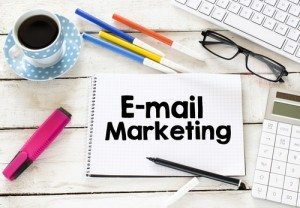{5:57 minutes to read} Email newsletters are an important part of engaging your clients and driving traffic to your blog.
The first step in creating a good newsletter is choosing a good return email address. The ideal address should ideally start with your name@ (this makes it personal, not generic); next best is “info@”. The domain should ideally be your company’s own (yourcompany.com), not a free one like Gmail or Yahoo.
The next step is a creating compelling subject line. Avoid terms like “free” or “new.” These are often used by email spammers & scammers, so readers are likely to mistake your email for spam and discard it.
The first email newsletters took their cue from paper newsletters. They weren’t sent out frequently, they were often from big companies with many contributors, and they would go on and on for ages. But with modern email newsletters, readers typically aren’t going to read through pages & pages of content (especially if they’re on a mobile device), so try to keep it short & compelling, with minimal scrolling.
What to Include in Your eNewsletter:
1. Your company logo or branding at the top
2. Short intro — a sentence or two greeting the reader
3. Titles, brief article excerpts & related images for 1-3 blog articles, all linking back to the relevant articles on your blog (where you want the reader to go anyway)
4. Call-to-action and signature, including your contact information, social media links, etc.
5. Any advertising disclaimer(s) / disclosures, as required
Introduction & Other Information: Newsletters sometimes include additional information in their intro section, such as:
Upcoming events — speaking engagements, conferences, seminars;
News related to your industry or brand; and
Growth as a professional — new locations, new people joining your team.
Excerpts: If readers are interested in the subject matter, and your excerpt gives them a compelling “teaser,” they will click through to read the rest of the article. If they’re not interested, they won’t click. It’s that simple.
Even if it’s not a blog article (perhaps it’s a web page or another kind of online article), it’s still best to include an excerpt. A newsletter should introduce the online content rather than contain it.
This is an important distinction!
You always want to drive the reader back to your website. If they have to go to your site in order to read the whole article, then they can look around and see other articles you’ve written, check out your firm, etc.
Signature: Always include a call-to-action. Ask the reader to do something, whether it’s sharing their opinions on the subject or calling/emailing you for a quote or further information. Make sure to include your contact information.
Disclaimers & Disclosures: Attorneys, CPAs, some financial & insurance professionals, and others may be required to include disclaimers in their newsletters. This is usually not merely a suggestion, but a legal requirement, so it’s important to be familiar with your industry’s disclaimer & disclosure requirements and to comply with them.
For example, the national and northeastern region’s bar associations require a statement that the newsletter may be considered “attorney advertising.” The IRS requires CPAs to include a disclaimer in all “circulars” (a category newsletters fall into). Other professionals may have to state that the communication does not constitute legal or financial advice — just to name a few.
Any email or content you send which is not addressing a client’s case, and could be considered promotional in any way, shape, or form for the purposes of expansion, acquiring new clients, etc. — irrespective of what you’re actually talking about in the newsletter — could fall under these requirements.
What NOT to Include:
1. Lots of lengthy articles or long introductions. They say that, when giving a speech, you should tell the audience what you’re going to tell them, tell them what you’re there to tell them, and then tell them again what you already told them. That is not the case with email newsletters. Make it quick & easy to consume.
2. Self-promoting or self-aggrandizing. Avoid “we’re the greatest” messages. Readers don’t want to read “Six Reasons You Should Choose Our Law Firm.” They want to know how you can help them — with their problem — in their situation. In other words, information that you can provide, that’s relevant & helpful to them.
- If you apply these tips to your newsletters, I think you’ll see very positive results long term.
- What kind of eNewsletters have you sent out in the past?
- Could they have produced better results if you had incorporated the tips above?
Mark Bullock
Telephone: (631) 754-0800
Email: Mark@phoneBlogger.net
Website:phoneBlogger.net




Great tips, as always. Thanks!